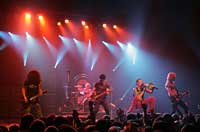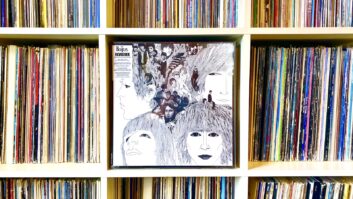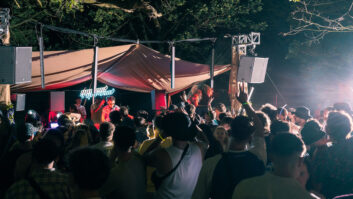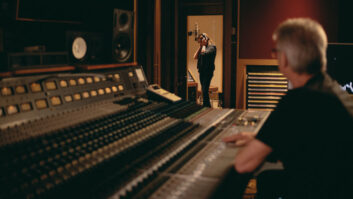
Photo: Steve Jennings
Velvet Revolver’s (comprising former members of some of hard rock’s revered bands, Stone Temple Pilots and Guns N’ Roses) theater jaunt is one of the most anticipated tours this summer. Ex-Stone Temple Pilots vocalist Scott Weiland kept the audience captive with his snake-like contortions, and was in top form vocally, while ex-GNR rockers Slash (guitar), Duff McKagen (bass), Matt Sorum (drums) and guitarist Dave Kushner had the place rockin’. Mix caught the show at The Warfield (San Francisco) in early June.
Front-of-house engineer Orris Henry
Photo: Steve Jennings
Front-of-house engineer Orris Henry is using a Midas XL4 on this tour because of its preamps and nice, warm sound, as well as the board’s logical layout. “You can watch the meter bridge as you’re looking at the stage to detect any problems and meter your gain structure without taking your eyes off the band.
“We run about 30 inputs — a lot for a four-piece band,” Henry continued. “A lot of the instruments are double-miked: I like to have the different tonal qualities of the different mics to work with. For instance, the kick has a Beta 91 and a Beta 52. The 91 gives the attack and the 52 gives the boom. The snare gets an SM57 on the top and an [Audio-Technica] 4050 on the bottom. The large-diaphragm 4050 picks up all the good rattle bits and delivers some extra bottom that most people roll off. I’ve got [AKG] 535s on the ride and hi-hat because they sound so natural. The toms get an older prototype mic that Beyer gave to drummer Matt [Sorum] when he was with The Cult. The overheads are 414s: They seem to sound the best to my ears.”
For bass, Henry uses a DI after the wireless for the clean tone, a DI after the bass amp to pick up the effects and a Sennheiser 421 in the Gallien Krueger speakers to pick up that “signature” Duff McKagen sound. “Duff also sings on a Beta 58. On Dave [Kushner’s] guitar, we liked the SM57 and [Audio-Technica] 4047 so much we tried it on Slash’s [lead guitarist] dirty sound; it was a perfect combo. Slash has a distinct tone and the 57 gives the bite and the 4047 gives the balls. Since this is a guitar band, you better have that covered. Slash also has a stereo clean sound that we mike with two 57s.The one unique sound we have is that Slash has a piezo pickup in one of his Les Pauls that gives a good high-gain, clean tone.”
Inside Henry’s rack are a TC Electronic D2 delay for vocal effects and an Eventide H3000 on the Voice-Doubler setting, which Henry notes has become a part of Weiland’s signature sound. Henry also uses an Eventide Eclipse for vocal distortion programs, a TC Electronic 5000 for vocal reverb and his old favorite Lexicon 224XL on drums. As for inserts, Henry relies on a BSS Audio 901 in-line with a Distressor for Weiland’s vocal, as well as Summit 200s on McKagen and Sorum’s vocals and on the bass DI and bass mic. On drums, Henry uses Drawmer gates and four Drawmer 241 comps for kick and snare. aAccording to Doug Kimball, who is manning a 48-channel ATI Paragon console at the monitor position, he has very little in his rack, as the Paragon has gates and comps on each channel.
Monitor engineer Doug Kimball
Photo: Steve Jennings
Kimball chose to put the band on Ultimate Ears in-ears after checking other brands “and no one comes close to them in consistency. I have Shure 600 ear transmitters for Scott and Dave. At show time, I mix solely for Scott with a full studio-type mix and effects left and right: Eventide 3500 for vocal doubling, SPX-990 for distortion and TC M5000 for delays. My third — Brian Ratchko — takes care of the rest of the band if there is a need. Slash, Duff and Matt are on wedges with two single-18s for side-fill ‘oomph.’ All in all, the band is very easy on the monitor dude.”





